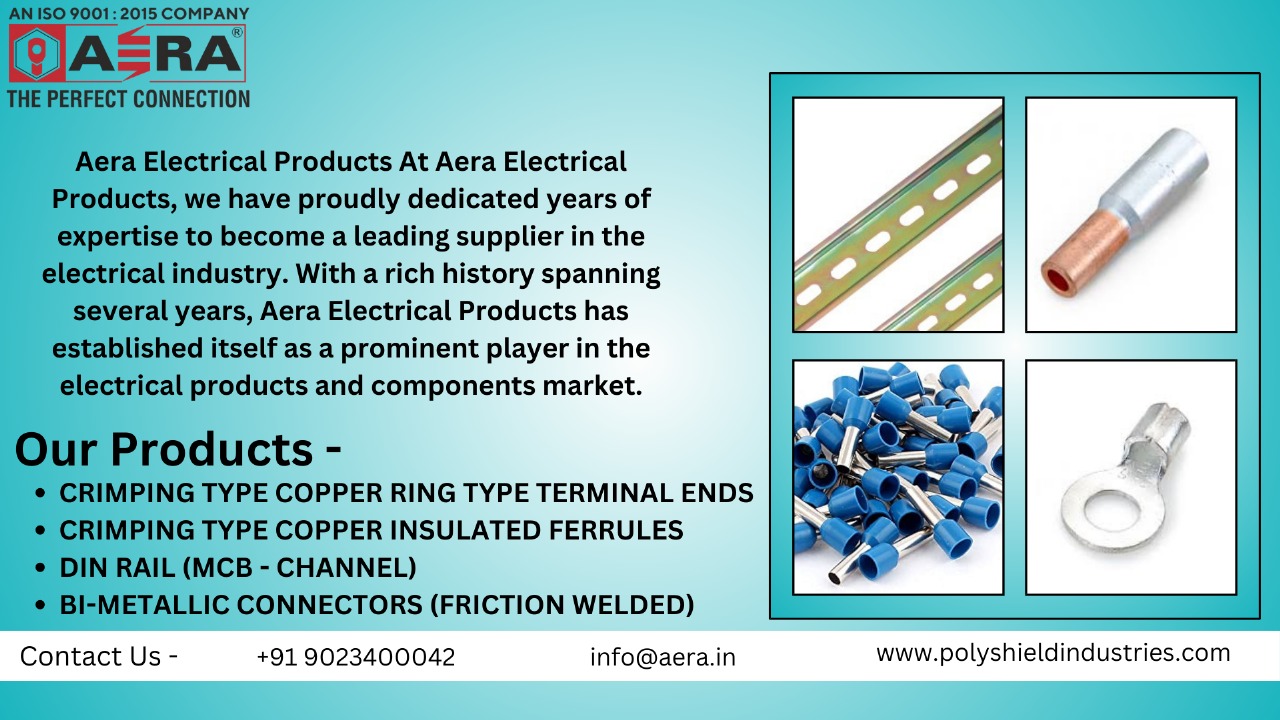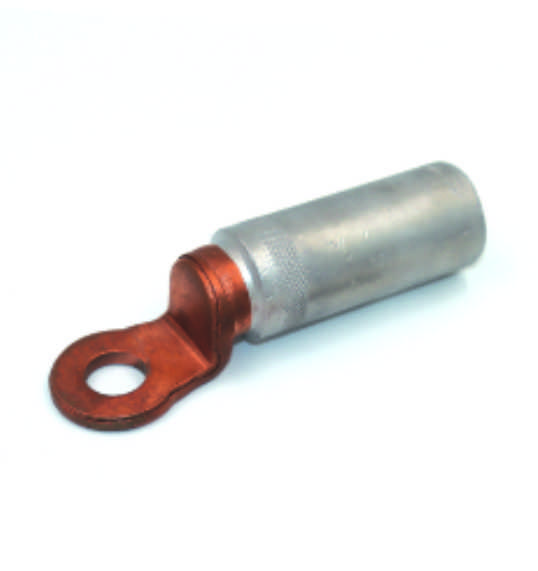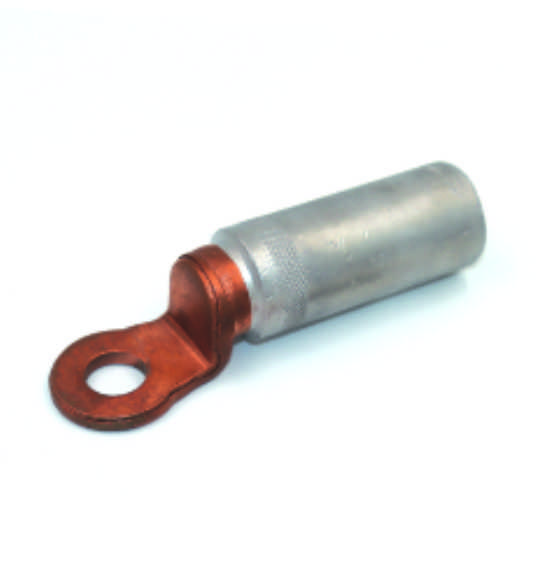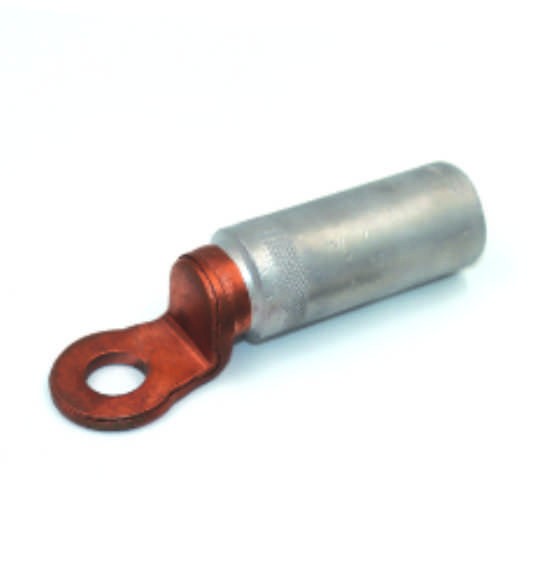
Crimping Type Copper In-Line Connectors (Heavy Duty)
Crimping Type Copper In-Line Connectors (Heavy
Duty)
CrimpingType Copper In-Line Connectors (Heavy Duty) are precision-engineered components used for
connecting or splicing electrical conductors, especially in high-current and
heavy-duty applications. Made from high-conductivity electrolytic copper,
these connectors are typically tin-plated for enhanced corrosion
resistance. The crimping process involves compressing the connector onto the
conductor using a specialized tool, forming a secure, permanent, and
low-resistance electrical connection. These connectors are crucial in power
distribution, industrial installations, and electrical maintenance.
Top 10 Frequently Asked Questions (FAQs) of Crimping
Type Copper In-Line Connectors (Heavy Duty)
- What are crimping type
copper in-line connectors used for?
- They are used to connect or
splice heavy-duty copper conductors in electrical systems.
- Why choose copper connectors
over aluminum?
- Copper has higher
conductivity, better corrosion resistance, and improved durability under
load.
- What does
"in-line" mean in this context?
- It means the connector
joins two conductors end-to-end, maintaining the same direction.
- Are these connectors
reusable?
- No, once crimped, they form
a permanent connection and cannot be reused.
- How are these connectors
installed?
- Using a hydraulic or
mechanical crimping tool designed for heavy-duty connectors.
- What sizes are available for
these connectors?
- They come in various sizes
to match conductor cross-sections, commonly ranging from 10mm² to 500mm²
or more.
- Why are they often
tin-plated?
- Tin plating prevents
oxidation, improves electrical contact, and enhances connector life.
- Are these connectors
suitable for outdoor use?
- Yes, especially when
insulated and sealed properly; the tin plating helps resist corrosion.
- What standards do these
connectors meet?
- Most comply with IEC, BS,
or ANSI standards for electrical fittings and connectors.
- What tools are required for
proper crimping?
- A heavy-duty hydraulic or
battery-operated crimping tool with appropriate dies.
Applications of Heavy-Duty Copper In-Line
Connectors
- Power distribution panels
and switchgear
- Underground cable jointing
- Industrial electrical
systems
- Renewable energy
installations (solar, wind)
- Data centers and server
rooms
- High-load electric motor
connections
- Shipbuilding and marine
electrical systems
- Railway electrification
projects
- Oil and gas industry
electrical infrastructure
- Emergency power supply
systems
Benefits of Using Heavy-Duty Crimping Type Copper
In-Line Connectors
- High Conductivity Ensures minimal power
loss and efficient current flow.
- Secure Mechanical Bond Crimping forms a strong,
vibration-resistant connection.
- Durability Withstands thermal and
mechanical stress in harsh environments.
- Corrosion Resistance Tin-plating protects the
copper from oxidation and corrosion.
- Low Electrical Resistance Promotes energy
efficiency and prevents overheating.
- Compact Design Ideal for space-limited
electrical panels or conduits.
- Safety Provides a stable and
reliable electrical connection, reducing fire risk.
- Compliance Meets international
electrical standards for safety and performance.
- Versatile Compatibility Can be used with stranded
or solid copper conductors.
- Easy Installation Simplifies field work
with standard crimping tools.
Contact us more details :
Call - +91
9023400042, +919099918363
Email - info@aera.in
Address -
A-12,MAHADEV ESTATE-2,B/H RAMOL POLICE STATION CTM-RAMOL ROAD RAMOL
AHMEDABAD-382449
Related Keywords
Quick Enquiry
Filter Using Product Tags
Crimping Type Copper Ring Terminal Ends| Copper Crimping Terminals| Ring Type Copper Terminal Ends| Copper Wire Crimp Terminals| Crimping Ring Terminals| Copper Crimp Terminals for Electrical Wiring| Ring Terminals for Copper Wire| Heavy Duty Copper Crimp Terminals| Copper Electrical Terminals| Copper Crimping Connector Terminals| Crimp Copper Terminals for Wire Connection| Copper Wire End Connectors| Industrial Crimping Terminals| Electrical Copper Ring Terminals| Copper Terminal Ends for Electrical Wire| Insulated Copper Ring Terminal Ends| Crimping Type Insulated Copper Terminals| Copper Insulated Crimp Terminals| Insulated Crimp Ring Terminals| Copper Ring Terminal Ends with Insulation| Electrical Insulated Crimp Terminals| Insulated Copper Electrical Terminals| Ring Type Insulated Copper Terminals| Insulated Copper Wire Crimp Terminals| Crimp Ring Terminals for Insulated Wires| Insulated Crimp Terminals for Electrical Wiring| Insulated Copper Terminals for Wire Connections| Insulated Crimp Copper Terminal Connectors| Ring Type Insulated Electrical Terminals| Insulated Copper Pin Terminal Ends| Crimping Copper Pin Type Terminals| Copper Pin Crimp Terminals (Insulated)| Insulated Copper Electrical Pin Terminals| Crimp Pin Terminals for Copper Wires| Copper Pin Type Terminal Ends with Insulation| Insulated Crimp Pin Connectors| Pin Type Crimp Terminals for Copper Wire| Insulated Copper Crimp Pin Connectors| Copper Pin Terminals for Electrical Wiring| Crimping Copper Pin Terminals (Insulated) for Wiring| Electrical Insulated Copper Pin Terminals| Insulated Copper Pin Connectors for Wiring| Heavy Duty Insulated Copper Pin Terminals| Insulated Crimp Pin Terminals for Electrical Connections| Copper Fork Terminal Ends| Crimping Type Copper Fork Terminals| Copper Fork Type Crimp Terminals| Crimp Fork Terminals for Copper Wire| Fork Type Copper Electrical Terminals| Copper Crimp Fork Terminal Connectors| Fork Crimp Terminals for Copper Wires| Copper Crimping Fork Terminals| High-Quality Copper Fork Terminals| Crimp Fork Connectors for Copper Wires| Copper Crimp Fork Terminals for Electrical Wiring| Heavy Duty Copper Fork Terminals| Fork Type Electrical Copper Terminals| Crimp Copper Fork Terminals for Wiring| Copper Fork Terminal Connectors for Electrical Applications| Insulated Copper Fork Terminal Ends| Crimping Copper Fork Terminals (Insulated)| Copper Fork Type Crimp Terminals (Insulated)| Insulated Copper Fork Terminals for Electrical Wiring| Fork Type Insulated Copper Crimp Terminals| Insulated Copper Fork Connectors| Electrical Insulated Copper Fork Terminals| Crimp Fork Terminals for Insulated Copper Wires| Insulated Fork Terminal Ends for Copper Wires| Heavy Duty Insulated Copper Fork Terminals| Copper Fork Crimp Terminals with Insulation| Fork Type Insulated Copper Electrical Terminals| Insulated Copper Fork Connectors for Wiring| Industrial Insulated Copper Fork Terminals| Insulated Copper Fork Terminals for Crimping| Copper Pin Terminal Ends| Crimping Type Copper Pin Terminals| Copper Pin Type Crimp Terminals| Pin Type Crimp Terminals for Copper Wire| Copper Crimp Pin Terminals| Crimp Pin Terminals for Copper Wires| Copper Pin End Terminals| Copper Electrical Pin Type Terminals| Heavy Duty Copper Pin Crimp Terminals| Pin Type Copper Electrical Terminals| Copper Pin Connectors for Crimping| High-Quality Copper Pin Terminals| Pin Type Crimp Connectors for Copper Wires| Copper Crimping Pin Terminals| Industrial Copper Pin Terminals for Crimping| Copper Insulated Ferrules| Crimping Copper Ferrules| Copper Insulated Crimp Ferrules| Insulated Copper Ferrules for Crimping| Crimp Copper Insulated Ferrules| Electrical Copper Ferrules (Insulated)| Copper Ferrules with Insulation| Insulated Ferrules for Copper Wires| Crimping Ferrules for Insulated Copper Wires| High-Quality Copper Insulated Ferrules| Insulated Copper Crimping Ferrule Connectors| Copper Crimp Ferrules with Insulation| Insulated Ferrules for Electrical Connections| Industrial Copper Insulated Ferrules| Copper Insulated Ferrules for Electrical Wiring| Copper Insulated Twin Cord Ferrules| Crimping Copper Twin Cord Ferrules| Insulated Twin Cord Ferrules for Copper Wires| Copper Twin Cord Crimp Ferrules| Crimp Copper Insulated Twin Ferrules| Twin Cord Copper Ferrules (Insulated)| Copper Insulated Ferrules for Twin Wires| Crimp Ferrules for Twin Copper Cords| Insulated Twin Cord Ferrules for Electrical Wiring| Copper Crimping Twin Cord Ferrules| Insulated Copper Twin Cord Ferrule Connectors| Electrical Twin Cord Copper Ferrules (Insulated)| High-Quality Copper Insulated Twin Ferrules| Copper Ferrules for Twin Wire Connections| Crimp Ferrules for Copper Twin Cord Wires| Copper Tubular Terminal Ends| Crimping Copper Tubular Terminals| Copper Tubular Crimp Terminals| Crimp Copper Tubular Terminal Connectors| Electrical Copper Tubular Terminals| Copper Tubular Crimping Terminals| Crimping Type Copper Terminals| Copper Tubular Connectors for Crimping| Industrial Copper Tubular Terminals| High-Quality Copper Tubular Terminal Ends| Copper Tubular Crimp Terminal Connectors| Heavy Duty Copper Tubular Crimp Terminals| Copper Crimping Tubular Terminals for Electrical Wiring| Tubular Copper Terminals for Crimping| Copper Tubular End Connectors| Copper In-Line Crimp Connectors| Crimping Type Copper Connectors| Copper In-Line Connectors for Crimping| Electrical Copper In-Line Crimp Connectors| Crimping Copper In-Line Connectors for Wiring| Copper In-Line Crimp Terminal Connectors| High-Quality Copper In-Line Connectors| Copper Crimp In-Line Connectors for Electrical Applications| In-Line Crimp Connectors for Copper Wires| Copper In-Line Wire Crimp Connectors| Industrial Copper In-Line Connectors| Crimping Connectors for Copper Wires (In-Line)| Copper In-Line Crimping Connectors for Electrical Connections| Copper Crimp Connectors for In-Line Wire Terminations| Best Copper In-Line Crimp Connectors for Wiring| Copper Tubular Terminal Ends (Long Barrel)| Long Barrel Copper Tubular Crimp Terminals| Crimping Copper Long Barrel Terminals| Copper Long Barrel Terminal Ends for Crimping| Long Barrel Copper Crimp Terminals| Copper Tubular Crimp Terminals (Long Barrel)| Electrical Copper Long Barrel Terminals| Long Barrel Crimp Connectors for Copper Wires| Heavy Duty Copper Tubular Terminal Ends (Long Barrel)| Copper Long Barrel Crimp Terminals for Electrical Wiring| Crimping Type Copper Tubular Terminals (Long Barrel)| Long Barrel Copper Crimping Connectors| Industrial Copper Tubular Terminals (Long Barrel)| Copper Crimping Long Barrel Terminal Ends| High-Quality Copper Long Barrel Crimp Terminals| Copper End Sealing Ferrules| Crimping Copper Ferrules| Copper End Sealing Ferrules for Wires| Crimping End Sealing Copper Ferrules| Copper Ferrules for End Sealing| End Sealing Copper Crimp Ferrules| Copper Ferrules with End Seal for Crimping| Crimp Copper End Sealing Ferrules| Electrical Copper End Sealing Ferrules| Copper Ferrules for Wire End Sealing| End Sealing Ferrules for Copper Wires| High-Quality Copper End Sealing Ferrules| Crimping Ferrules with Copper End Seal| Industrial Copper End Sealing Ferrules| Copper Crimp Ferrules for End Sealing| Heavy Duty Copper Tubular Terminal Ends| Crimping Type Heavy Duty Copper Terminals| Heavy Duty Copper Tubular Crimp Terminals| Copper Heavy Duty Crimp Terminal Ends| Heavy Duty Copper Crimp Terminal Connectors| Crimping Copper Tubular Terminals for Heavy Duty Use| Copper Heavy Duty Terminal Ends for Crimping| Industrial Copper Tubular Terminal Ends (Heavy Duty)| High-Quality Heavy Duty Copper Tubular Terminals| Copper Crimp Terminals for Heavy Duty Applications| Copper Tubular Crimp Terminals (Heavy Duty) for Wiring| Heavy Duty Copper Crimping Terminal Connectors| Durable Copper Tubular Terminal Ends (Heavy Duty)| Heavy Duty Copper Terminal Ends for Electrical Wiring| Copper Tubular Crimp Connectors (Heavy Duty)| Heavy Duty Copper In-Line Connectors| Crimping Type Heavy Duty Copper Connectors| Heavy Duty Copper In-Line Crimp Connectors| Crimp Copper In-Line Connectors (Heavy Duty)| Copper In-Line Connectors for Heavy Duty Applications| Heavy Duty Copper Electrical In-Line Connectors| Copper In-Line Crimp Connectors for Heavy Duty Use| Industrial Heavy Duty Copper In-Line Connectors| High-Quality Heavy Duty Copper In-Line Connectors| Copper Crimp In-Line Connectors for Heavy Duty Wiring| Heavy Duty Copper In-Line Wire Connectors| Copper In-Line Crimp Connectors for Industrial Use| Durable Heavy Duty Copper In-Line Connectors| Crimping Connectors for Heavy Duty Copper Wires| Copper Heavy Duty In-Line Crimping Connectors| Copper Long Palm Two Hole Terminal Ends| Crimping Type Copper Two Hole Tubular Terminals| Copper Long Palm Crimp Terminals| Two Hole Copper Tubular Terminal Ends| Copper Two Hole Tubular Crimp Terminals| Copper Two Hole Long Palm Terminal Connectors| Crimping Copper Two Hole Terminal Ends| Heavy Duty Copper Long Palm Terminal Ends| Copper Long Palm Crimping Terminals for Wiring| Industrial Copper Two Hole Tubular Terminals| Copper Tubular Terminals (Two Hole) for Crimping| Long Palm Copper Crimp Terminals with Two Holes| Two Hole Tubular Copper Terminals for Electrical Applications| Crimp Type Copper Long Palm Two Hole Terminal Connectors| Two Hole Copper Crimping Terminals for Electrical Wiring| Copper Four Hole Tubular Terminal Ends| Crimping Type Copper Four Hole Terminals| Copper Four Hole Crimp Terminals| Four Hole Copper Tubular Crimp Terminals| Copper Four Hole Terminal Connectors| Crimping Copper Four Hole Tubular Terminals| Heavy Duty Copper Four Hole Terminal Ends| Copper Four Hole Crimping Terminals for Wiring| Copper Four Hole Tubular Terminals for Electrical Connections| Industrial Copper Four Hole Crimp Terminals| Copper Four Hole Terminal Ends for Electrical Wiring| High-Quality Copper Four Hole Crimp Terminals| Four Hole Copper Tubular Terminals for Crimping| Copper Four Hole Crimp Connectors for Electrical Systems| Durable Copper Four Hole Terminal Ends| Aluminium Tubular Terminal Ends| Crimping Type Aluminium Terminal Ends| Aluminium Tubular Crimp Terminals| Crimp Aluminium Tubular Terminals| Aluminium Crimp Terminals for Wiring| Industrial Aluminium Tubular Terminals| Crimping Aluminium Terminal Connectors| High-Quality Aluminium Tubular Crimp Terminals| Aluminium Tubular Crimp Connectors for Electrical Wiring| Aluminium Crimping Tubular Terminals for Electrical Applications| Aluminium Crimp Tubular Terminals for Heavy Duty| Crimping Aluminium Tubular Terminals for Industrial Use| Copper and Aluminium Crimp Tubular Terminal Ends| Aluminium Tubular Terminals for Electrical Connections| Durable Aluminium Crimp Terminals for Wiring| Aluminium Tubular Terminal Ends (Long Barrel)| Crimping Aluminium Long Barrel Terminal Ends| Aluminium Long Barrel Crimp Terminals| Long Barrel Aluminium Tubular Terminals| Crimp Aluminium Long Barrel Tubular Terminals| Industrial Aluminium Long Barrel Terminals| Aluminium Crimp Terminals with Long Barrel| Long Barrel Aluminium Crimping Terminals| High-Quality Aluminium Long Barrel Terminal Ends| Crimping Aluminium Long Barrel Connectors| Long Barrel Aluminium Crimp Connectors| Heavy Duty Aluminium Tubular Terminals (Long Barrel)| Aluminium Long Barrel Crimping Terminal Connectors| Long Barrel Aluminium Terminals for Crimping| Aluminium Tubular Long Barrel Terminals for Electrical Wiring| Aluminium In-Line Connectors| Crimping Type Aluminium Connectors| Aluminium In-Line Crimp Connectors| Crimp Aluminium In-Line Connectors| Aluminium Crimp Connectors for In-Line Applications| In-Line Crimping Aluminium Connectors| High-Quality Aluminium In-Line Connectors| Industrial Aluminium In-Line Crimp Connectors| Aluminium Crimp In-Line Terminal Connectors| Crimping In-Line Aluminium Connectors for Electrical Wiring| Durable Aluminium In-Line Crimp Connectors| Aluminium In-Line Wire Connectors| Heavy Duty Aluminium In-Line Crimp Connectors| Affordable Aluminium In-Line Crimp Connectors for Wiring| Aluminium Crimp In-Line Connectors for Industrial Use| Aluminium Reducer Type Terminal Ends| Crimping Aluminium Reducer Terminals| Aluminium Reducer Crimp Terminals| Crimp Type Aluminium Reducer Connectors| Aluminium Reducer Terminals for Crimping| Aluminium Crimp Reducer Terminal Ends| Aluminium Terminal Ends (Reducer Type)| Heavy Duty Aluminium Reducer Terminal Ends| Crimping Aluminium Reducer Connectors for Wiring| Industrial Aluminium Reducer Crimp Terminals| Aluminium Crimp Reducer Connectors for Electrical Applications| High-Quality Aluminium Reducer Crimp Terminals| Aluminium Crimp Terminals for Reduced Connections| Durable Aluminium Reducer Type Terminals| Aluminium Crimp Reducer Type Terminals for Industrial Use| DIN Rail C-Channel| C-Channel DIN Rail Mounting| DIN Rail for Electrical Installations| C-Channel DIN Rail for Panel Mounting| Industrial C-Channel DIN Rail| DIN Rail C-Channel for Electrical Equipment| Heavy Duty C-Channel DIN Rail| Best DIN Rail C-Channel for Wiring| C-Channel DIN Rails for Electrical Systems| High-Quality C-Channel DIN Rail| DIN Rail C-Channel for Industrial Use| Durable C-Channel DIN Rails| C-Channel DIN Rail for Automation Panels| C-Channel DIN Rail for Electrical Panel Mounting| Electrical C-Channel DIN Rails| Snap-On Type Terminal Ends| Snap-On Electrical Terminal Ends| Snap-On Crimp Terminal Connectors| Snap-On Type Terminals for Electrical Wiring| Snap-On Terminal Ends for Crimping| Snap-On Wire Connectors| Snap-On Connectors for Electrical Terminals| High-Quality Snap-On Terminal Ends| Snap-On Type Terminals for Electrical Systems| Snap-On Electrical Crimp Terminals| Snap-On Terminals for Industrial Use| Snap-On Type Terminal Connectors for Wiring| Durable Snap-On Electrical Terminals| Snap-On Connectors for High-Voltage Wiring| Snap-On Terminal Ends for Quick Connections| Copper Tubular Terminal Ends for XLPE Cable| Crimping Copper Terminal Ends for XLPE Wires| Copper Tubular Crimp Terminals for XLPE Cable| XLPE Cable Crimping Copper Terminal Connectors| Copper Tubular Crimp Terminals for XLPE Cable Wiring| Crimp Type Copper Terminal Ends for XLPE Insulated Cable| Copper Crimp Terminals for XLPE Cable Applications| XLPE Cable Crimping Terminal Connectors| High-Quality Copper Tubular Terminals for XLPE Cables| Copper Tubular Crimp Connectors for XLPE Electrical Cable| Durable Copper Crimping Terminal Ends for XLPE Cable| Copper XLPE Cable Crimp Terminal Connectors| Industrial Copper Tubular Terminals for XLPE Cable| Crimp Type Copper XLPE Cable Terminals| XLPE Cable Crimping Copper Tubular Terminals for Electrical Wiring| Copper Reducer Type Terminal Ends| Crimping Copper Reducer Terminals| Copper Reducer Crimp Terminals| Crimp Type Copper Reducer Connectors| Copper Crimp Reducer Terminal Ends| Copper Reducer Crimp Connectors| Copper Reducer Type Crimping Terminals| Industrial Copper Reducer Terminal Ends| High-Quality Copper Reducer Crimp Terminals| Copper Crimping Reducer Terminal Connectors| Durable Copper Reducer Type Crimp Terminals| Copper Reducer Type Terminals for Electrical Systems| Copper Crimp Connectors with Reducer Type Terminals| Best Copper Reducer Type Terminal Ends for Wiring| Copper Crimp Terminals for Reduced Wiring Connections| Bi-Metallic Connectors Friction Welded| Friction Welded Bi-Metallic Connectors| Bi-Metallic Friction Welded Connectors for Electrical Systems| High-Quality Bi-Metallic Connectors (Friction Welded)| Friction Welded Bi-Metallic Cable Connectors| Bi-Metallic Connectors for Electrical Wiring (Friction Welded)| Friction Welded Bi-Metallic Connectors for Power Transmission| Industrial Bi-Metallic Connectors (Friction Welded)| Bi-Metallic Connectors with Friction Welding Technology| Friction Welded Bi-Metallic Electrical Connectors| Best Bi-Metallic Connectors for Electrical Systems (Friction Welded)| Durable Friction Welded Bi-Metallic Connectors| Bi-Metallic Friction Welded Connectors for Heavy Duty| Bi-Metallic Connectors for High Voltage (Friction Welded)| Affordable Bi-Metallic Friction Welded Connectors| Bi-Metallic Terminals Friction Welded| Friction Welded Bi-Metallic Terminals| Bi-Metallic Electrical Terminals (Friction Welded)| Friction Welded Bi-Metallic Cable Terminals| High-Quality Bi-Metallic Terminals (Friction Welded)| Bi-Metallic Terminals for Electrical Wiring (Friction Welded)| Friction Welded Terminals for Bi-Metallic Cables| Industrial Bi-Metallic Terminals (Friction Welded)| Durable Bi-Metallic Friction Welded Terminals| Bi-Metallic Cable Terminals (Friction Welded) for Power Systems| Best Bi-Metallic Terminals for Electrical Applications (Friction Welded)| Friction Welded Bi-Metallic Cable Joining Terminals| Bi-Metallic Power Cable Terminals (Friction Welded)| Friction Welded Bi-Metallic Terminals for Heavy Duty Applications| Bi-Metallic Electrical Terminals with Friction Welding Technology| DIN Rail MCB Channel| MCB DIN Rail Mounting Channel| DIN Rail for MCB Circuit Breakers| MCB Channel DIN Rail for Electrical Panels| DIN Rail for MCB Installation| MCB Mounting Channel for DIN Rail| High-Quality DIN Rail MCB Channel| MCB DIN Rail for Electrical Systems| MCB Channel for DIN Rail Mounting| Durable DIN Rail MCB Channel| DIN Rail for MCB Circuit Breaker Panel| MCB Mounting Rail (DIN Standard)| Affordable DIN Rail MCB Channel for Panels| MCB DIN Rail for Industrial Electrical Use| Standard DIN Rail for MCB Circuit Breakers|



Our Products
Popular Links
Get In Touch
A-12,MAHADEV ESTATE-2,B/H RAMOL POLICE STATION CTM-RAMOL ROAD RAMOL AHMEDABAD-382449
info@aera.in
+91 9023400042
+919099918363
© Aera Electrical Products . All Rights Reserved.
Designed by industrieslead.com



